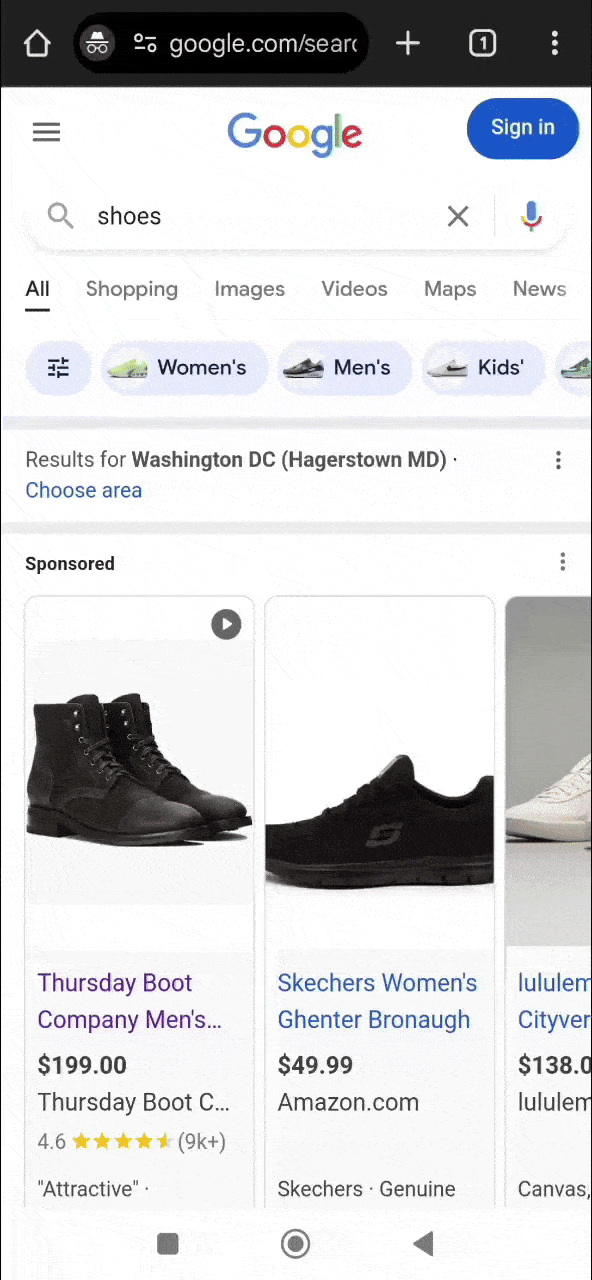Google Tests Video-Enabled Shopping Ads in Search Results

Introduction
Google is once again pushing the boundaries of digital advertising, this time with a test that integrates video-enabled shopping ads directly into search results. This potential new feature allows users to watch product videos within the search page, which could lead to higher ad engagement. However, it also raises questions about how it might impact traffic to advertisers’ websites, as Google seeks to keep users within its ecosystem.
How Google’s Video-Enabled Shopping Ads Work

The functionality being tested is straightforward but significant in its implications. Here is a breakdown of how it works:
-
Video Play Icon:
Shopping ads display a video play icon, indicating that users can view product videos directly within the search results.
-
Hover Functionality:
When a user hovers over the icon, it transforms into a “watch” button, further encouraging interaction.
-
Inline Video Player:
Clicking on the button opens an inline video player, playing looped footage of the product without the need to navigate to another page.
-
Engagement Within Search Results:
The video plays directly on the search engine results page (SERP), allowing users to view product details without leaving Google’s platform.
This test introduces an engaging element to search ads that could significantly change user behaviour.
Why Video-Enabled Ads Could Boost Engagement
It is no secret that video content tends to outperform static images when it comes to user engagement. People are naturally drawn to motion, and videos offer a more dynamic and immersive way to showcase a product’s features. By adding video functionality to shopping ads, Google could help advertisers capture more attention and encourage deeper engagement with their ads.
Here are a few reasons why video-enabled ads might lead to better performance:
-
Higher Engagement Rates:
Video ads have consistently been shown to result in higher engagement than static ads. The ability to view a product in action can give users a more complete understanding of what they are buying.
-
Instant Gratification:
Users can see product details without navigating away from the search results, making it easier to gather information quickly.
-
Rich Media Appeal:
As consumers increasingly expect rich media content, video ads cater to this demand, offering a more interactive and visually appealing experience.
However, with these potential benefits come certain trade-offs that advertisers must be aware of.
Less Traffic to Landing Pages
While video-enabled shopping ads might increase engagement with the ads themselves, they could also result in fewer users clicking through to advertisers’ websites. Google’s emphasis on keeping users within its own ecosystem could lead to a significant shift in how advertisers measure success.
Here is why this is concerning:
-
Decreased Website Traffic:
By allowing users to view product information directly in the SERP, fewer users may feel the need to visit the advertiser’s landing page. This could result in a drop in website traffic, which has traditionally been a key metric for measuring the success of ads.
-
Shift in Measurement Focus:
As a result, advertisers may need to shift their focus from website visits to in-ad interactions, such as video views and engagement within the ad itself. This could change the way success is measured and how campaigns are optimised.
In essence, Google’s move to retain users on its platform may alter the traditional dynamics of digital advertising, forcing advertisers to rethink their strategies.
Google’s Ongoing Interest in Rich Media Ads
This is not Google’s first attempt at incorporating video into its search ads. A similar test was conducted in 2018, highlighting the company’s ongoing interest in rich media ad formats. Google clearly sees value in providing advertisers with more engaging ways to showcase their products, and video is a natural fit for this purpose.
While performance data from this current test is not yet available, previous studies suggest that video ads typically show higher engagement than their static counterparts. This test is just another example of how Google is blurring the lines between traditional search ads and more immersive, rich media advertising.
What Is Next for Google Ads?
This test is part of a broader trend where Google seems to be moving towards making the search experience more interactive. Recent tests of expandable product ads carousels also point in this direction, as the company experiments with different ways to present product information without requiring users to leave the SERP.
For advertisers, this means adapting to a world where traffic to landing pages may become less of a priority, while engagement with ads becomes the new focal point. Video-enabled shopping ads could potentially open up new opportunities for showcasing products, but they also come with new challenges. Understanding how to optimise for this new ad format will be key to staying competitive.
What to Keep in Mind
As this test unfolds, there are several key factors a digital advertiser should keep an eye on:
-
Broader Rollout:
If this test proves successful, Google may roll it out to more advertisers. Keep an eye on whether this functionality becomes available more widely.
-
Impact on Ecommerce Conversion Rates:
While video ads might boost engagement, it is important to keep an eye on how they will impact ecommerce conversion rates.
-
Shifting Metrics:
Advertisers may need to start focusing on new performance metrics, such as video views, engagement rates, and in-ad interactions, rather than just website visits.
Conclusion
Google’s test of video-enabled shopping ads represents a potential shift in how advertisers approach digital advertising. While video ads offer the promise of higher engagement, they also present challenges in terms of driving traffic to landing pages. As Google continues to blur the lines between search and rich media ads, advertisers will need to adapt their strategies to succeed in this evolving landscape.
By staying informed and adjusting to new metrics and formats, businesses can leverage this new video functionality to enhance their advertising campaigns and connect with users in more engaging ways. Keep a close watch on this development, as it could significantly impact the future of ecommerce and digital advertising.
(Source)
Know Similar Updates
To take full advantage of video-enabled shopping ads, ensure your video content is high-quality, visually engaging, and provides clear product information. Focus on making the video informative yet concise, as it will likely loop and need to convey the product’s key features quickly.
It is too early to tell how this feature will impact conversion rates. While video-enabled ads may increase engagement with the ads themselves, there is concern that fewer users will click through to landing pages, which could affect conversions. Advertisers should monitor how this change affects their overall sales funnel.
This test indicates that Google is moving towards more interactive and rich media formats in its search results, with a focus on keeping users within its ecosystem. As these changes roll out, advertisers may need to adapt their strategies to focus on in-ad engagement rather than relying solely on driving traffic to their websites.





